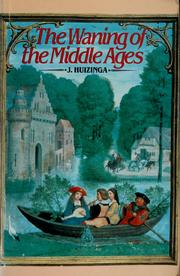Check nearby libraries
Buy this book

From the Preface of the English translation...
The present work deals with the history of the fourteenth and fifteenth centuries regarded as a period of termination, as the close of the Middle Ages. Such a view of them presented itself to the author of this volume, whilst endeavouring to arrive at a genuine understanding of the art of the brothers Van Eyck and their contemporaries, that is to say, to grasp its meaning by seeing it in connection with the entire life of their times. Now the common feature of the various manifestations of civilization of that epoch proved to be inherent rather in that which links them to the past than in the germs which they contain of the future. The significance, not of the artists alone, but also of theologians, poets, chroniclers, princes and statesmen, could be best appreciated by considering them, not as the harbingers of a coming culture, but as perfecting and concluding the old.
This English edition is not a simple translation of the original Dutch (second edition 1921, first 1919), but the result of a work of adaptation, reduction and consolidation under the author's directions. The references, here left out, may be found in full in the original.
Check nearby libraries
Buy this book

Previews available in: Dutch Italian English Croatian Spanish
Subjects
Art, Medieval, Civilization, Civilization, Medieval, Fifteenth century, Fourteenth century, History, Medieval Art, Medieval Civilization, Middle Ages, Social history, Social life and customs, Manners and customs, Conditions sociales, Civilisation médiévale, Moyen Âge, Cultuurgeschiedenis, Social conditions, Middle ages, history, France, social life and customs, Netherlands, social life and customs, Civilisation, Netherlands, history, Europe, history, 476-1492, Civilisation medievale, Mœurs et coutumes, French language books, Idade me dia, Civilización -, FRANCIA, Sec. 14.-15, Civiltà, France, civilization, Netherlands, civilizationPlaces
France, Netherlands, belgium, Pays-Bas, Franc ʹa;holandaTimes
1000-1328, 1328-1600, Medieval, 500-1500Showing 11 featured editions. View all 105 editions?
Book Details
Table of Contents
Edition Notes
Bibliography: p. 309-318.
Reprint. Originally published: London : E. Arnold, 1924.
Translation of: Herfsttij der Middeleeuwen.
Includes index.
Classifications
The Physical Object
ID Numbers
Source records
Scriblio MARC recordmarc_cca MARC record
Internet Archive item record
Library of Congress MARC record
marc_uic MARC record
Better World Books record
harvard_bibliographic_metadata record
marc_columbia MARC record
Work Description
Herfsttij der Middeleeuwen is het bekendste werk van de historicus Johan Huizinga uit 1919.
In het werk presenteert Huizinga het idee dat de overdreven formaliteit en romantiek van het laatmiddeleeuwse hofleven een verdedigingsmechanisme was tegen de toenemende verruwing van de maatschappij.
Huizinga gebruikte voor Herfsttij kronieken en literatuur als bronnen en bewust geen archiefstukken. Zijn boek is, meer dan een kunsthistorische studie, een proeve van cultuur- en mentaliteitsgeschiedenis.
Source: Wikipedia
From the Preface of the English translation:
The present work deals with the history of the fourteenth and fifteenth centuries regarded as a period of termination, as the close of the Middle Ages. Such a view of them presented itself to the author of this volume, whilst endeavouring to arrive at a genuine understanding of the art of the brothers Van Eyck and their contemporaries, that is to say, to grasp its meaning by seeing it in connection with the entire life of their times. Now the common feature of the various manifestations of civilization of that epoch proved to be inherent rather in that which links them to the past than in the germs which they contain of the future. The significance, not of the artists alone, but also of theologians, poets, chroniclers, princes and statesmen, could be best appreciated by considering them, not as the harbingers of a coming culture, but as perfecting and concluding the old.
This English edition is not a simple translation of the original Dutch (second edition 1921, first 1919), but the result of a work of adaptation, reduction and consolidation under the author's directions. The references, here left out, may be found in full in the original.
Community Reviews (0)
Feedback?| March 14, 2024 | Edited by Miguel | Edited without comment. |
| March 14, 2024 | Edited by Miguel | Edited without comment. |
| March 14, 2024 | Edited by bitnapper | Merge works (MRID: 123454) |
| March 14, 2024 | Edited by Miguel | Edited without comment. |
| December 9, 2009 | Created by WorkBot | add works page |

























